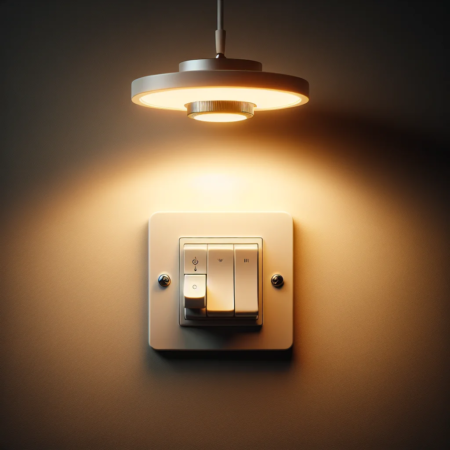Check out this Youtube video: “NO EARTH LIGHTING. What to do if you replace a …” to learn whether or not LED ceiling lights need an earth connection.

Contents
- 1 Understanding the Earth Wire
- 2 Do LED Ceiling Lights Need an Earth?
- 3 How to Connect Earth Wire to LED Ceiling Lights
- 3.1 1. Gather Your Tools and Materials
- 3.2 2. Turn Off Power
- 3.3 3. Identify the Earth Wire
- 3.4 4. Connect the Earth Wire
- 3.5 5. Secure with Electrical Tape
- 3.6 6. Test for Power
- 3.7 7. Install the Light Fixture
- 3.8 8. Restore Power
- 3.9 Anecdotes from Electricians or DIY Enthusiasts
- 3.10 Examples of LED Ceiling Light Fixtures Requiring an Earth Wire
- 4 Ensuring Safety and Compliance
- 5 The Importance of Grounding LED Ceiling Lights
- 6 Frequently Asked Questions
Understanding the Earth Wire
The earth wire, also known as the grounding wire, is an essential component in electrical systems that serves to provide a safe path for excess electrical current to flow into the ground. It is typically marked with the color green and yellow stripes to signify its distinctive purpose in the electrical setup.
Definition of earth wire in electrical systems
The earth wire serves as a protective measure to prevent live wire overloading, absorb excess electrons, and channelize them to flow beneath the ground. By establishing a reliable path for fault currents, grounding prevents potential shocks, fires, and damage to sensitive electronic devices.
Importance of grounding in electrical fixtures
Grounding is crucial in ensuring electrical safety as it protects people and equipment from electric shocks, lightning strikes, and electrical noise. There are various types of grounding systems, including safety grounding, equipment grounding, and system grounding, each playing a vital role in maintaining voltage levels and preventing electrical malfunctions.
The table below summarizes the key points:
| Earth Wire | Function |
|---|---|
| Prevents Overloading | Avoids live wire overloading and current leakage through the ground. |
| Absorbs Excess Electrons | Provides a path for excess electrical current to flow into the ground. |
| Ensures Safety | Protects people and equipment from electric shock, lightning strikes, and electrical noise. |
| Types of Grounding Systems | Safety Grounding, Equipment Grounding, and System Grounding, each with distinct safety and functional roles. |
Understanding the earth wire and its significance in electrical systems is paramount for ensuring safety and preventing potential electrical hazards.
Do LED Ceiling Lights Need an Earth?
LED ceiling lights do not necessarily require grounding due to their low voltage and reduced electrical hazard. However, grounding serves as a crucial safety feature in AC wiring, diverting excess energy during power surges or storms to the ground for safe discharge, preventing potential electrical hazards and ensuring user safety.
Explanation of why LED ceiling lights need to be grounded
Grounding is essential for LED ceiling lights in cases of unexpected voltage surges, power spikes, or lightning strikes, as it provides a path for excess electrical current to safely dissipate into the ground. It helps prevent electrical shock, fires, and damage to the lighting fixtures, ensuring a secure and reliable electrical system.
Examples of scenarios where LED ceiling lights require an earth wire
In commercial or industrial settings, LED ceiling lights may require an earth wire to comply with electrical codes and regulations, especially in high-risk environments where electrical safety standards are critical. Additionally, when installing LED ceiling lights in areas prone to power fluctuations or extreme weather conditions, grounding becomes essential to protect the fixtures and ensure user safety.
Counterarguments on the necessity of an earth wire for LED ceiling lights
Some may argue that LED ceiling lights operating on low voltage do not pose significant electrical hazards, thus questioning the necessity of grounding. However, in the interest of comprehensive safety measures, grounding LED ceiling lights provides an added layer of protection against unforeseen electrical events, safeguarding both the lighting system and occupants.
| Pros of Grounding LED Ceiling Lights | Cons of Not Grounding LED Ceiling Lights |
|---|---|
| Provides a path for excess electrical current during power surges | Increased risk of electrical shock and fires |
| Enhances electrical system safety and reliability | Non-compliance with electrical codes and regulations |
| Protects against potential damage from lightning strikes | Compromised user safety and security |
| Ensures adherence to safety standards in high-risk environments | Susceptibility to power fluctuations and extreme weather |
How to Connect Earth Wire to LED Ceiling Lights
To properly connect an earth wire to LED ceiling lights, follow these step-by-step instructions:
1. Gather Your Tools and Materials
Be prepared with the necessary tools and materials, including wire strippers, electrical tape, wire nuts, a voltage tester, and the LED ceiling lights.
2. Turn Off Power
Before starting, ensure to turn off the power to the circuit at the breaker box to guarantee safety.
3. Identify the Earth Wire
Locate the earth wire, which is typically colored green or marked with yellow and green stripes. It is crucial for grounding the light fixture.
4. Connect the Earth Wire
Connect the earth wire from the LED ceiling light to the earth wire in the electrical box using a wire nut. Ensure a secure connection.
5. Secure with Electrical Tape
Once the connection is made, use electrical tape to secure the wire nut and ensure the wires are insulated.
6. Test for Power
After connecting the earth wire, use a voltage tester to ensure that the power is off before proceeding.
7. Install the Light Fixture
Follow the manufacturer’s instructions to install the LED ceiling light fixture securely.
8. Restore Power
Once it’s installed, restore power to the circuit and test the light to ensure it’s functioning properly.
Anecdotes from Electricians or DIY Enthusiasts
Electricians and DIY enthusiasts often emphasize the significance of properly connecting the earth wire to LED ceiling lights. Many stress the importance of safety and adherence to electrical codes when dealing with electrical connections, including earth wire installations.
Examples of LED Ceiling Light Fixtures Requiring an Earth Wire
Several LED ceiling light fixtures, such as those with metal housings or external metal components, require an earth wire for proper grounding. It’s essential to refer to the manufacturer’s specifications for each specific fixture to determine the need for an earth wire.
| LED Ceiling Light Fixture | Earth Wire Requirement |
|---|---|
| Modern Sleek Design | Yes |
| Traditional Glass Fixture | No |
Ensuring Safety and Compliance
Statistics on electrical safety incidents related to LED ceiling lights
Electrical safety incidents related to LED ceiling lights are a concern due to potential hazards such as electric shocks, malfunctions, and fires. According to workplace injury and fatality statistics, improper installation and wiring deficiencies often contribute to these incidents.
For instance, failed power cords occur most frequently in table lamps, indicating the need for proper installation and maintenance practices to prevent accidents.
Historical facts on the development of electrical safety standards for LED fixtures
The history of electrical safety standards for LED fixtures is closely intertwined with the evolution of electrical technology. As long as electricity has existed, safety requirements have continuously evolved to address the specific challenges posed by innovative lighting products.
The need for comprehensive safety norms became particularly apparent with the introduction of LED technology, which required distinct standards for installation and usage to ensure safety and compliance.
Importance of ensuring compliance with electrical regulations when installing LED ceiling lights
Ensuring compliance with electrical regulations during the installation of LED ceiling lights is crucial for preventing potential hazards and ensuring the safety of individuals and properties. Neglecting proper wiring and electrical connections can lead to a range of issues, including electrical hazards, malfunctions, and fires.
Prioritizing compliance with safety regulations is essential to prevent electric shocks, fire hazards, and structural damage, underscoring the importance of adhering to established electrical standards.
| Electrical Safety Incidents | LED Ceiling Lights |
|---|---|
| Failed bulbs most frequent in table lamps | Improper installation contributing to safety incidents |
| Power cord failures common in table lamps | Evolution of safety standards with LED technology |
The Importance of Grounding LED Ceiling Lights
In the world of lighting, grounding plays a crucial role in ensuring safety and compliance, especially when it comes to LED ceiling lights. Proper grounding is essential for diverting excess electrical energy during power surges or storms, safeguarding individuals and property from potential harm. Without adequate grounding, LED lights may experience issues such as flickering, reduced lifespan, or even permanent damage due to inadequate dissipation of electrical energy.
To ensure the safety and optimal performance of LED ceiling lights, it is important to adhere to best practices for grounding. This includes:
-
Inspecting Wiring: Prior to installation, thoroughly inspect the wiring to ensure that the grounding system is in place and functioning effectively.
-
Using Quality Fixtures: Opt for LED light fixtures that come with adequate grounding or insulation, thereby minimizing the need for separate grounding.
-
Following Manufacturer’s Instructions: Pay close attention to the manufacturer’s guidelines to ensure proper installation and grounding of LED lights.
In the context of LED ceiling lights, it’s important to emphasize the relevance of proper electrical installation practices for various fixtures. Adhering to industry standards and recommendations for grounding not only ensures compliance but also contributes to the overall safety and performance of lighting systems.
Recap of the necessity of grounding LED ceiling lights for safety and compliance
When it comes to LED ceiling lights, the necessity of grounding cannot be overstated. It serves as a fundamental safety measure, redirecting excess electrical energy to prevent potential hazards such as power surges, flickering, and compromised longevity of LED lights.
In addition, compliance with grounding requirements is essential for meeting safety regulations and standards, safeguarding against electrical malfunctions and hazards.
To summarize, the key takeaways on the necessity of grounding LED ceiling lights include:
-
Safety Enhancement: Grounding significantly enhances safety by diverting excessive electrical energy away from lighting fixtures, reducing the risk of electrical hazards.
-
Compliance Requirements: Proper grounding is crucial for meeting regulatory standards and industry requirements, ensuring that LED lighting installations remain in line with safety protocols and guidelines.
The proper grounding of LED ceiling lights is pivotal for maintaining safety, longevity, and compliance with industry standards. By following best practices and adhering to the manufacturer’s recommendations, individuals can ensure that their LED lighting systems are grounded effectively, thereby mitigating potential risks and optimizing performance.
To provide a more comprehensive understanding of the importance of grounding LED ceiling lights, below is a table summarizing the key factors and considerations associated with this critical aspect of lighting installations:
| Key Factors | Considerations |
|---|---|
| Safety Enhancement | Redirecting excess electrical energy to prevent hazards |
| Compliance Requirements | Meeting regulatory standards and industry guidelines for electrical safety and performance |





